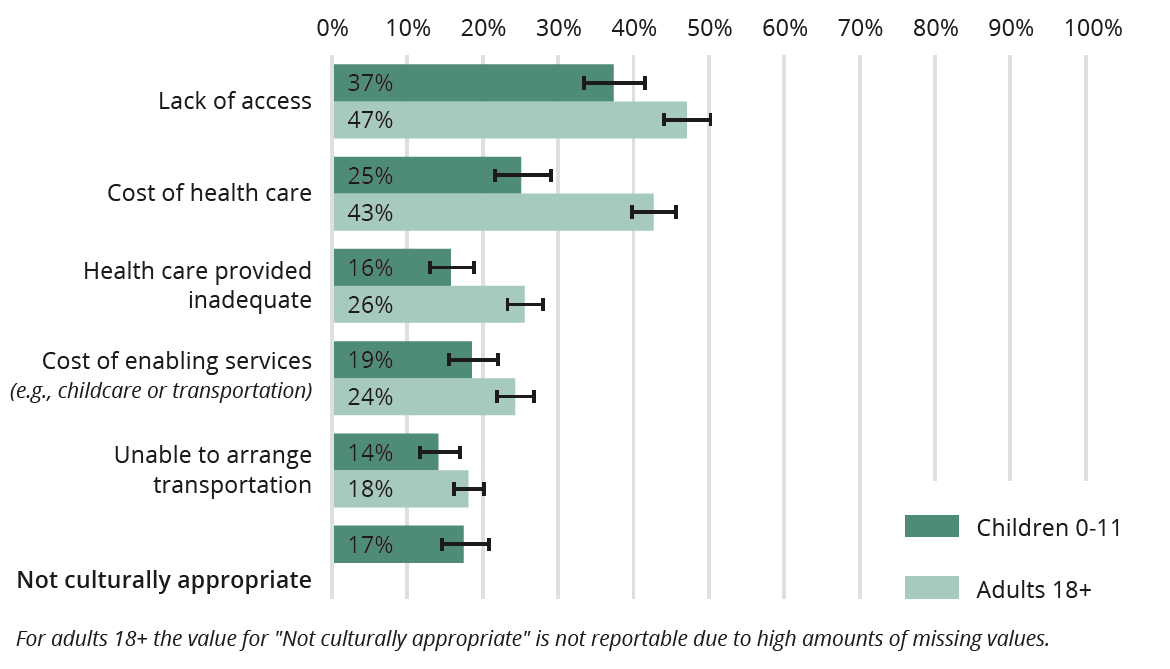
What is the Regional Health Survey: Phase Four?
The Regional Health Survey (RHS) is a Canada-wide survey for First Nations people living in community. The survey is planned and funded nationally by the First Nations Information Governance Centre (FNIGC), while the First Nations Health Authority (FNHA) carries out the survey in British Columbia.
Now in its fourth phase, results from the RHS have been used to support policy, funding, decision making and programming at the community, regional, provincial and national level.
Rooted in Traditional and western understandings of health and well-being, the RHS gathers information from First Nations people living on reserve and in Northern First Nations communities in a culturally safe and accessible way. In the past, these important groups have been left out from other surveys and/or have not seen any benefit from participation.
Here are some quick facts on the RHS4:
What kind of questions are in the RHS4?
The RHS4 looks at health related topics from an Indigenous and western worldview, health behaviours, conditions, access to healthcare and your environment. Some areas we want to know more about are:
| Traditional Wellness | Water Quality | Connection to land |
| Culture & Language | Mental Wellness | Housing Conditions |
| Primary Care | Diabetes | COVID impacts |
| Effects of colonialism | Community Wellness | Vaccine Coverage |
| Substance Use | Food Security & Nutrition | General Health |
What we can continue to learn through the RHS
The hope is that the information collected in this survey can inform health planning at a community level and beyond. As the health needs of communities change, the information we collect can and will change. The RHS questions were developed to look at Indigenous health from multiple lenses which includes a holistic approach to knowledge gathering, and understanding that health is influenced by physical, social and environmental factors. Also, gathering information in phases can help us see health trends and the big picture of First Nations health in BC and trends that may develop over time.
FNIGC Video on RHS Surveys
Past Reports
Three phases of the survey have been conducted with First Nations in BC: Phase One (2002– 2003), Phase Two (2008–2010) and Phase Three (2015–2017).
Phase three, or RHS3, was the first time the FNHA carried out the survey. These reports have valuable information on the health status of First Nations at that point in time.
Just like RHS3, RHS4 will also contain a provincial report, as well as regional reports.
Highlights from past surveys
The previous phases of the RHS has shown many improvements in health and wellness trends, for example rates of smoking and early-childhood education. However, they have also highlighted areas to focus on in the future to better First Nations health and wellness.
Attendance to the Aboriginal Head Start on-reserve (AHSOR) programs increased significantly in years:
| Phase of RHS | Percent of Children who have attended an AHSOR Program |
| One (2002-2003) | 46% |
| Two (2008-2010) | 49% |
| Three (2015 - 2017) | 56% |
Smoking rates have decreased significantly in years, especially for the Youth!
| Phase of RHS | Adult Smoking rates | Youth smoking rates |
| One (2002-2003) | 49% | 27% |
| Two (2008-2010) | 45% | 23% |
| Three (2015 - 2017) | 41% | 13% |
Barriers in access to health care is an ongoing issue that requires changes in health care provision systems. Different barriers to receiving care are shown below. For example, cost of health care being a barrier for 25% of children signals the need for inspecting the implementation of Jordan's principle.

How surveys helped COVID-19 vaccine rollout planning
One concrete way that data collected from the RHS has helped First Nations people was being given early access to the COVID-19 vaccine.
The beginning of the COVID-19 pandemic were uncertain times for all, and the scientists, public health officials, and policy makers had difficult choices to make when it came to giving out limited vaccine doses. The health policy makers of BC looked at the amount of vaccines available and who they thought would benefit most from receiving a vaccine. Although at the time there was a limited understanding of COVID-19, they did know that chronic disease, house overcrowding and access to healthcare were big risk factors for getting COVID-19. Because of the 2018 RHS report, advocates had recent, reliable data on the health of First Nations people in BC, and they showed that the these three factors affected First Nations in BC more than the general population. Taking everything into account, the BC provincial government decided to deliver the initial doses of COVID-19 vaccine to older adults, and First Nations people, both in-community and away from home, above the age 18.
Information Governance
We are proudly acknowledging and following the OCAP® Principles throughout our survey, from data collection to distribution. OCAP® means that the Ownership, Control, Access and Possession of data belongs to the communities that the data is collected from.
More specifically, these terms show that a community or group owns information collectively in the same way that an individual owns their own personal information. First Nations communities have control over (and can decide) how information about them is collected, used and disclosed. First Nations must have access to data about themselves and their communities, regardless of where it is currently held. The data is owned by First Nations communities for RHS4 are stewarded by FNHA and FNIGC. The data is either in First Nation's possession or in the possession of a trusted organization.
More on OCAP® can be found here.
OCAP video if FNIGC on YouTube:
Data Return
Following the OCAP® Principles, we acknowledge that the owner of the data is the communities themselves, and will do our best to serve the communities for their data needs.
Once the data is collected through the RHS, we will analyze and summarize the data. FNIGC will release a National report, and the FNHA will release provincial and regional reports.
The surveys team is committed to returning community level data back when possible. Participating communities work with their appointed Field Supervisor and the analysis team to create a data return plan.
How the RHS works
Since we cannot survey all First Nations people living in BC, we use a subset (or a sample) which represents the wider population. The RHS4 uses a random sample, which means everyone has an equal chance of being chosen. A certain number of people are chosen to participate in the child, youth and adult surveys, which is based on the size of the communities. Names are picked randomly so everyone has an equal chance of being chosen. This continues until we have an even number of participants in each sub-group. Please note: participants can self-identify their gender.

